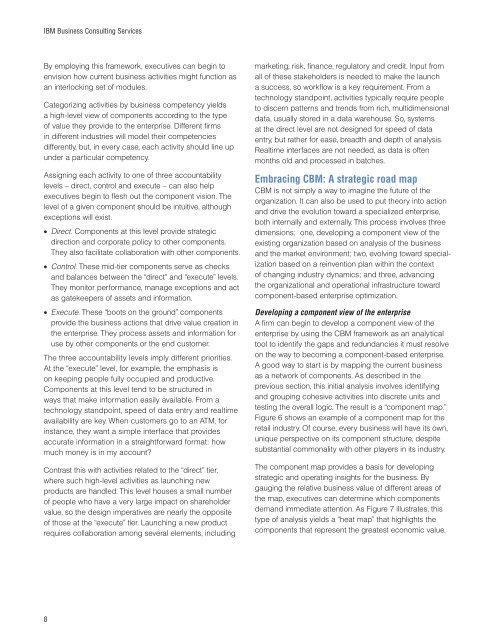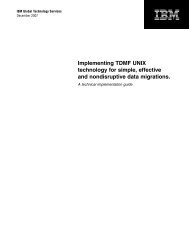Component business models - IBM
Component business models - IBM
Component business models - IBM
You also want an ePaper? Increase the reach of your titles
YUMPU automatically turns print PDFs into web optimized ePapers that Google loves.
<strong>IBM</strong> Business Consulting Services<br />
By employing this framework, executives can begin to<br />
envision how current <strong>business</strong> activities might function as<br />
an interlocking set of modules.<br />
Categorizing activities by <strong>business</strong> competency yields<br />
a high-level view of components according to the type<br />
of value they provide to the enterprise. Different firms<br />
in different industries will model their competencies<br />
differently, but, in every case, each activity should line up<br />
under a particular competency.<br />
Assigning each activity to one of three accountability<br />
levels – direct, control and execute – can also help<br />
executives begin to flesh out the component vision. The<br />
level of a given component should be intuitive, although<br />
exceptions will exist.<br />
• Direct. <strong>Component</strong>s at this level provide strategic<br />
direction and corporate policy to other components.<br />
They also facilitate collaboration with other components.<br />
• Control. These mid-tier components serve as checks<br />
and balances between the “direct” and “execute” levels.<br />
They monitor performance, manage exceptions and act<br />
as gatekeepers of assets and information.<br />
• Execute. These “boots on the ground” components<br />
provide the <strong>business</strong> actions that drive value creation in<br />
the enterprise. They process assets and information for<br />
use by other components or the end customer.<br />
The three accountability levels imply different priorities.<br />
At the “execute” level, for example, the emphasis is<br />
on keeping people fully occupied and productive.<br />
<strong>Component</strong>s at this level tend to be structured in<br />
ways that make information easily available. From a<br />
technology standpoint, speed of data entry and realtime<br />
availability are key. When customers go to an ATM, for<br />
instance, they want a simple interface that provides<br />
accurate information in a straightforward format: how<br />
much money is in my account?<br />
Contrast this with activities related to the “direct” tier,<br />
where such high-level activities as launching new<br />
products are handled. This level houses a small number<br />
of people who have a very large impact on shareholder<br />
value, so the design imperatives are nearly the opposite<br />
of those at the “execute” tier. Launching a new product<br />
requires collaboration among several elements, including<br />
8<br />
marketing, risk, finance, regulatory and credit. Input from<br />
all of these stakeholders is needed to make the launch<br />
a success, so workflow is a key requirement. From a<br />
technology standpoint, activities typically require people<br />
to discern patterns and trends from rich, multidimensional<br />
data, usually stored in a data warehouse. So, systems<br />
at the direct level are not designed for speed of data<br />
entry, but rather for ease, breadth and depth of analysis.<br />
Realtime interfaces are not needed, as data is often<br />
months old and processed in batches.<br />
Embracing CBM: A strategic road map<br />
CBM is not simply a way to imagine the future of the<br />
organization. It can also be used to put theory into action<br />
and drive the evolution toward a specialized enterprise,<br />
both internally and externally. This process involves three<br />
dimensions: one, developing a component view of the<br />
existing organization based on analysis of the <strong>business</strong><br />
and the market environment; two, evolving toward specialization<br />
based on a reinvention plan within the context<br />
of changing industry dynamics; and three, advancing<br />
the organizational and operational infrastructure toward<br />
component-based enterprise optimization.<br />
Developing a component view of the enterprise<br />
A firm can begin to develop a component view of the<br />
enterprise by using the CBM framework as an analytical<br />
tool to identify the gaps and redundancies it must resolve<br />
on the way to becoming a component-based enterprise.<br />
A good way to start is by mapping the current <strong>business</strong><br />
as a network of components. As described in the<br />
previous section, this initial analysis involves identifying<br />
and grouping cohesive activities into discrete units and<br />
testing the overall logic. The result is a “component map.”<br />
Figure 6 shows an example of a component map for the<br />
retail industry. Of course, every <strong>business</strong> will have its own,<br />
unique perspective on its component structure, despite<br />
substantial commonality with other players in its industry.<br />
The component map provides a basis for developing<br />
strategic and operating insights for the <strong>business</strong>. By<br />
gauging the relative <strong>business</strong> value of different areas of<br />
the map, executives can determine which components<br />
demand immediate attention. As Figure 7 illustrates, this<br />
type of analysis yields a “heat map” that highlights the<br />
components that represent the greatest economic value.

















